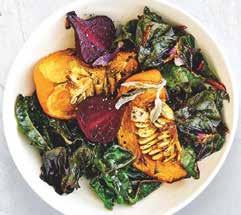
19 minute read
A FEAST FOR
A Feast for All Seasons Embracing the Rainbow Year Round by April Thompson N o matter where we live, eating seasonally in winter doesn’t have to be boring or limiting; a culinary adventure awaits the home chef that’s willing to leave avocados and asparagus to their rightful seasons and embrace the winter rainbow of bitter greens, sweet potatoes, sunny citrus and fuchsia beets, among other timely delicacies.
Advertisement
“Sometimes people think of winter foods as brown and soft and boring, and it’s absolutely not the case. Winter brings bright things like pomegranates, beets and citrus, which offer color and acidity,” says Brigit Binns, the Paso Robles, California author of 30 cookbooks, including Cooking in Season: 100 Recipes for Eating Fresh. Eating seasonally is especially important in winter, says Shannon Stonger of Texas, author of Simple Food for Winter: 30 Grain-Free Recipes to Get You Through the Dark Days. “Winter foods like fermented vegetables, root vegetables, squashes and hardy greens are especially helpful in the colder, darker months, when our bodies are in need of comfort foods as well as pre- and probiotic foods,” says Stonger, a homesteader and founder of the blog NourishingDays.com. There are plenty of other reasons to stick to a seasonal diet in winter, adds Binns. “Food always tastes better in the season it was intended to be eaten in. Seasonal foods are naturally ripened, rather than harvested early and trucked in. In addition to enhanced flavor, eating seasonally helps minimize use of fossil fuels to bring our food to us, and is likely to be less expensive.” Winterizing the Kitchen Much of the fall harvest, particularly root vegetables, stores well through the winter (hence the idea of a root cellar), extending produce across seasons, according to Steven Satterfield, chef and author of Root to Leaf: A Southern Chef Cooks Through the Seasons. There are lots of root vegetables beyond just carrots and potatoes to be enjoyed in winter, including sunchokes, parsnips and turnips, which can be used creatively rather than “boiled to death,” says Satterfield. For example, the Atlanta restaurateur incorporates parsnips into an upside-down cake with winter spices like nutmeg, black pepper and ginger.
Binns likes to add texture to winter dishes with nuts, color with herbs, and crunch with a winter vegetable like fennel. Warming soups are always comforting during the coldest season, but she also likes warm salads, like a beet and escarole salad drizzled with a warm sherry vinaigrette. Satterfield suggests that specialty citrus like blood oranges, Meyer lemons
Join our email list and receive your E-edition before it hits the news stands!

8 Jacksonville / St. Augustine NAJax.com Hong Vo/Shutterstock.com Daxiao Productions/Shutterstock.com health briefs Maintain a Healthy Diet and Weight to Lower Cataract Risk A recent study published in The Journal of Nutrition used adherence to dietary guidelines and total diet scores to assess the effects of diet on cataract risk.
The researchers followed 2,173 older Australians for five and 10 years in two phases. They found that maintaining a healthy body mass index (BMI) of less than 25, combined with a healthy diet, reduced the risk of developing cataracts. Reduce Blood Pressure and Heart Attacks With Better Gut Bacteria New research offers potential paths for treatment for the nearly 20 percent of patients with high blood pressure that don’t respond well to medications. University of Florida College of Medicine researchers, testing 105 volunteers, found that the populations of gut bacteria differed between hypertensive individuals with depression and those without depression. A second study by Italian researchers found that patients with heart attacks had different bacteria in their guts than patients with stable angina. Eat a Better Diet to Improve Gut Bacteria Researchers at the University of Hawaii Cancer Center tested stool samples of 858 men and 877 women in Los Angeles and Hawaii with a mean age of 69—regarded as an ethnically diverse study population with varied food intakes. The study found that those with higher quality diets also had significantly better gut bacteria diversity, a factor linked to reduced risk for a variety of diseases. Diet quality and a reduced risk of developing chronic disease is strongly associated with fecal microbial diversity. Eat Mushrooms to Lower Risk of Prostate Cancer
Researchers followed more than 36,000 Japanese
men older than 40 for an average of 13.2 years. They found that those that consumed culinary mushrooms three times a week had a 17 percent lower chance of developing prostate cancer compared to those that ate mushrooms less than once a week. Participants that ate mushrooms once or twice a week had an 8 percent lower risk. The trend was even greater for those men over the age of 50 and was unrelated to other dietary habits.
Train Students in Mindfulness to
Reduce Stress and Improve Grades Sixth-graders that received mindfulness training each day for eight weeks experienced lower stress levels, less depression and improved academic
performance compared to their peers in a control group that studied computer coding, report
Massachusetts Institute of Technology researchers. In addition to that 100-student study, researchers surveyed 2,000 students in grades five through eight and found those that showed more mindfulness tended to have better grades and test scores. They also had fewer absences and suspensions. SK Design/Shutterstock.com
community spotlight

9 December 2019 A. Schaeffer-Pautz, MD Combining Traditional, Integrative and Anthroposophic Medicine for Well-Being and Balance O n the east coast of Florida, just a few blocks from the ocean, sits one of the South’s few anthroposophically oriented medical practices. The Persephone Healing Arts Center, in Jacksonville Beach, has a wonderful, natural atmosphere enhanced by the spirit and focus of A. Schaeffer-Pautz, MD. Brought up in a Waldorf school environment, Dr. Pautz is double board certified in both integrative and internal medicine and combines the best of both worlds in her treatment of patients. Her goal is to help her patients achieve their highest level of well-being and balance, using natural approaches whenever possible.
This philosophy is evident from the first view of the center: a cozy waiting room looks out onto a lovely garden area where patients can relax in the sun or rest in a spot of shade beneath the trees. Care here is particularly unique—first visits can be two or more hours of one-on-one time with the physician. Dr. Pautz takes time to learn all she can about a patient’s physical, mental and emotional well-being and then fuses her knowledge of traditional, integrative and anthroposophic medicine (a philosophy that embraces physical, emotional and spiritual aspects of the human being) to provide individual recommendations designed to work on the root of the problem. Her treatments are focused on lifestyle changes, counseling and nutrition, and this focus helps her patients not only deal with their health issues, but also maintain their higher level of wellness once the immediate problem is dealt with.
Dr. Pautz’s technique has particularly helped those with chronic disorders and diseases such as depression, autism, cancer and any other internal medical disease. Her conviction that all facets of the person must be in balance for ultimate well-being leads to personalized treatments that examine and help each individual to achieve their level of optimum health. This insightful approach often offers relief to patients who have exhausted their traditional western medical options and are seeking help in alternate methods.
Patients may also undergo extensive counseling to facilitate profound lifestyle changes and new ways of looking at things. They receive individualized nutritional guidelines in the hopes of facilitating improved health and releasing what needs to be transitioned.
The philosophy “you are what you eat” has never been as true as in today’s quick meal society, and few know the effects of dietary choices better than Dr. Pautz. Providing your body with the fuel and tools necessary for its well-being is the first building block toward total health and healing. Combining her knowledge of medicine and nutrition, she targets habits that contribute to particular disorders and advises her patients in their diets to strengthen their immune systems and help their bodies stay strong.
In treating her patients, Dr. Pautz has noticed that their nutritional habits have stemmed from a lack of knowledge about how to prepare healthful dishes. After encountering this need for education, she developed classes in the past that were focused on nutritional cooking, emphasizing the use of whole grains, tons of herbs, fresh fruits and vegetables. With a healthy diet as a base to grow from, therapies then perform better as the body becomes more receptive, receiving the aid the therapies provide. Dr. Pautz can easily suggest recipes in-session with wholesome foods that might be a first step in implementation. Another unique remedy at Dr. Pautz’s disposal is therapeutic eurythmy, an expressive form of movement therapy. Based on the philosophy of Rudolf Steiner, eurythmy uses movements to express sounds and music. One of the few medical doctors to be certified in eurythmy, Dr. Pautz uses this approach to supplement the treatment of a variety of physical, medical and emotional ailments. Somewhat like its Asian counterparts, tai chi and yoga, eurythmy helps a person connect to and experience the nontangible realities of spirit and energy that are essential for all souls.
Dr. Pautz’s varied background and extensive training provide her with myriad treatment choices to draw from in her practice. Whether addressing cancer, diabetes, asthma, common cold, multiples sclerosis, rheumatoid arthritis, ALS or any other illness, her treatments are personalized, insightful and far-reaching. By balancing Western and integrative medicine and avoiding chemical drugs whenever possible, Dr. Pautz provides each patient with the opportunity for a road map to longlasting, deep-seated health changes through nutritional and lifestyle advice, naturopathy, homeopathy, counseling, anthroposophic medicine, and art and movement therapy. Persephone Healing Arts Center is located at 485 6th Ave. N., in Jacksonville Beach. To learn more, call 904-246-3583, visit DrPautz.com or join them for one of their monthly open houses. Join them on Facebook. See ad on the back cover. A. Schaeffer-Pautz, MD
9 December 2019 8 Jacksonville / St. Augustine NAJax.com community spotlight A. Schaeffer-Pautz, MD Combining Traditional, Integrative and Anthroposophic Medicine for Well-Being and Balance O n the east coast of Florida, just a few blocks from the ocean, sits one of the South’s few anthro - posophically oriented medical practices. The Persephone Healing Arts Center, in Jacksonville Beach, has a wonderful, natural atmosphere enhanced by the spirit and focus of A. Schaeffer-Pautz, MD. Brought up in a Waldorf school environment, Dr. Pautz is double board certified in both integrative and internal medicine and combines the best of both worlds in her treatment of patients. Her goal is to help her patients achieve their highest level of well-being and balance, using natural approaches whenever possible. This philosophy is evident from the first view of the center: a cozy waiting room looks out onto a lovely garden area where patients can relax in the sun or rest in a spot of shade beneath the trees. Care here is particularly unique—first visits can be two or more hours of one-on-one time with the physician. Dr. Pautz takes time to learn all she can about a patient’s physical, mental and emotional well-being and then fuses her knowledge of traditional, integrative and anthroposophic medicine (a philoso - phy that embraces physical, emotional and spiritual aspects of the human being) to provide individual recommendations designed to work on the root of the prob - lem. Her treatments are focused on lifestyle changes, counseling and nutrition, and this focus helps her patients not only deal with their health issues, but also maintain their higher level of wellness once the immediate problem is dealt with. Dr. Pautz’s technique has particularly helped those with chronic disorders and diseases such as depression, autism, cancer and any other internal medical disease. Her conviction that all facets of the person must be in balance for ultimate well-being leads to personalized treatments that examine and help each individual to achieve their level of optimum health. This insightful approach often offers relief to patients who have exhausted their traditional western medical options and are seeking help in alternate methods. Patients may also undergo extensive counseling to facilitate profound lifestyle changes and new ways of looking at things. They receive individualized nutritional guidelines in the hopes of facilitating improved health and releasing what needs to be transitioned. The philosophy “you are what you eat” has never been as true as in today’s quick meal society, and few know the effects of di - etary choices better than Dr. Pautz. Providing your body with the fuel and tools necessary for its well-being is the first building block toward total health and healing. Combining her knowledge of medicine and nutrition, she targets habits that contribute to particular disorders and advises her patients in their diets to strengthen their immune systems and help their bodies stay strong. In treating her patients, Dr. Pautz has noticed that their nutritional habits have stemmed from a lack of knowledge about how to prepare healthful dishes. After encountering this need for education, she developed classes in the past that were focused on nutritional cooking, emphasiz - ing the use of whole grains, tons of herbs, fresh fruits and vegetables. With a healthy diet as a base to grow from, therapies then perform better as the body becomes more receptive, receiving the aid the therapies provide. Dr. Pautz can easily suggest reci - pes in-session with wholesome foods that might be a first step in implementation. Another unique remedy at Dr. Pautz’s disposal is therapeutic eurythmy, an expres - sive form of movement therapy. Based on the philosophy of Rudolf Steiner, eurythmy uses movements to express sounds and music. One of the few medical doctors to be certified in eurythmy, Dr. Pautz uses this approach to supplement the treatment of a variety of physical, medical and emotional ailments. Somewhat like its Asian counter - parts, tai chi and yoga, eurythmy helps a person connect to and experience the non-tangible realities of spirit and energy that are essential for all souls. Dr. Pautz’s varied background and extensive training provide her with myriad treatment choices to draw from in her prac - tice. Whether addressing cancer, diabetes, asthma, common cold, multiples sclerosis, rheumatoid arthritis, ALS or any other illness, her treatments are personalized, insightful and far-reaching. By balancing Western and integrative medicine and avoiding chemical drugs whenever pos - sible, Dr. Pautz provides each patient with the opportunity for a road map to long-lasting, deep-seated health changes through nutritional and lifestyle advice, naturopathy, homeopathy, counseling, anthroposophic medicine, and art and movement therapy. Persephone Healing Arts Center is located at 485 6th Ave. N., in Jacksonville Beach. To learn more, call 904-246-3583, visit DrPautz.com or join them for one of their monthly open houses. Join them on Facebook. See ad on the back cover. A. Schaeffer-Pautz, MD Hong Vo/Shutterstock.comDaxiao Productions/Shutterstock.com health briefs Maintain a Healthy Diet and Weight to Lower Cataract RiskA recent study published in The Journal of Nutrition used adherence to dietary guidelines and total diet scores to assess the effects of diet on cataract risk. The researchers followed 2,173 older Australians for five and 10 years in two phases. They found that maintaining a healthy body mass index (BMI) of less than 25, combined with a healthy diet, reduced the risk of developing cataracts. Reduce Blood Pressure and Heart Attacks With Better Gut BacteriaNew research offers po - tential paths for treatment for the nearly 20 percent of patients with high blood pressure that don’t respond well to medications. Uni - versity of Florida College of Medicine researchers, test - ing 105 volunteers, found that the populations of gut bacteria differed between hypertensive individuals with depression and those without depression. A second study by Italian researchers found that patients with heart attacks had different bacteria in their guts than patients with stable angina. Eat a Better Diet to Improve Gut BacteriaResearchers at the University of Hawaii Cancer Center tested stool samples of 858 men and 877 women in Los Angeles and Hawaii with a mean age of 69—regarded as an ethnically diverse study population with varied food intakes. The study found that those with higher quality diets also had significantly better gut bacteria diversity, a factor linked to reduced risk for a variety of diseases. Diet quality and a reduced risk of developing chronic disease is strongly associated with fecal microbial diversity. Eat Mushrooms to Lower Risk of Prostate Cancer Researchers followed more than 36,000 Japanese men older than 40 for an average of 13.2 years. They found that those that consumed culinary mushrooms three times a week had a 17 percent lower chance of developing prostate cancer compared to those that ate mushrooms less than once a week. Participants that ate mushrooms once or twice a week had an 8 percent lower risk. The trend was even greater for those men over the age of 50 and was unrelated to other dietary habits. Train Students in Mindfulness to Reduce Stress and Improve Grades Sixth-graders that received mindful - ness training each day for eight weeks experienced lower stress levels, less depression and improved academic performance compared to their peers in a control group that studied computer coding, report Massachusetts Institute of Technology researchers. In addition to that 100-student study, researchers surveyed 2,000 stu - dents in grades five through eight and found those that showed more mindfulness tended to have better grades and test scores. They also had fewer absences and suspensions. SK Design/Shutterstock.com
To join, email Publisher@VoFLNatural.com

and cross-hybridized varieties such as tangelos and pomelos are fun to intersperse with winter vegetables to maximize brightness and freshness. A lot of winter produce can be great in raw form as well, he adds, including Brussels sprouts, rutabaga or daikon radish, shaved thinly or julienned into a salad.
Winter squash is a favorite staple of the Stonger family in the cooler months. “It is easy to grow, easy to store and so deliciously sweet and rich. We roast it as a side dish, mash it as a sort of breakfast porridge or make soups and curries from it,” says Stonger.
Satterfield suggests using all the parts of winter vegetables to maximize the harvest and minimize food waste. For example, the seeds of winter squashes can be roasted with herbs and spices and eaten as is, churned into other dishes such as a squash seed granola or blended and strained into a homemade broth to add some texture, fat and flavor. After roasting carrots with Moroccan spices, Satterfield suggests taking the leafy carrot tops and chopping them with cilantro and garlic to make a green sauce to crown the carrots. Swiss chard stems can also be chopped and cooked into Portuguese bread soup, with leftover stale bread made into olive oil croutons and egg whites stirred in at the end.






Winter Health Boosters Beyond selecting seasonal produce, chefs recommend a few key dietary tweaks in winter, such as stepping up vitamin D consumption. “Since you’re not seeing a lot of sun this time of year, it’s more important to get it through colorful vegetables like carrots, cabbage or radicchio. Watermelon radishes are another winter vegetable full of vitamins,” says Binns. “You can grow your own sprouts throughout the winter as a great microgreen option. Sprouts are incredibly high in enzymes, something often lacking in other winter dishes,” suggests Stonger. “Fermented vegetables and other fermented foods can make up the difference in winter.”
April Thompson is a freelance writer in Washington, D.C. Connect at AprilWrites.com.

If you look into your own heart, and you find nothing wrong there, what is there to worry about? What is there to fear? ~Confucius
For the vinaigrette: Fresh orange juice or as needed 1 Tbsp champagne vinegar ¼ cup extra-virgin olive oil Sea salt and freshly ground pepper
Mixed Citrus Salad With Mâche, Fennel and Celery

Winter is the height of citrus season, with an appealing display of oranges, mandarins, tangerines, tangelos, pomelos and more in the best-stocked markets. Use a varied mixture of sweet-tart types for the prettiest, tastiest salad.
Yields: 4 servings
2 ribs celery 2 bunches mâche 2 lb mixed citrus fruits, such as navel oranges, blood oranges, tangerines, mandarins and pomelos ½ fennel bulb, trimmed 8 kumquats ¼ cup sliced almonds, toasted
Natural Awakenings recommends using organic, non-GMO (genetically modified) and non-bromated ingredients whenever possible.

Cut the celery in half lengthwise. Using a serrated vegetable peeler or a mandoline, shave the celery into thin strips lengthwise down the ribs. Cut the strips in half crosswise and place in a bowl of water. Set aside.
Separate the mâche leaves and transfer to a shallow serving bowl. Working on a plate to capture all the juices, use a serrated knife to cut a thick slice off the top and bottom of each citrus fruit. Working with one fruit at a time, stand it upright and, following the contour of the fruit, carefully slice downward to remove the peel, pith and membrane. Set the fruit on its side and cut crosswise into slices about ⅜-inch thick, discarding any seeds. Transfer the slices to the bowl with the mâche, reserving the juices for the vinaigrette.
Cut the fennel lengthwise in half. Using a mandoline or a sharp knife, cut the fennel crosswise into very thin slices and tuck among the citrus slices. Drain the celery and distribute evenly over the salad. Using the serrated knife, cut each kumquat crosswise into very thin slices, discarding any seeds. Scatter the kumquat slices evenly over the salad, then sprinkle the almonds over the top.
To make the vinaigrette, pour the reserved citrus juices into a measuring cup. Add
enough additional orange juice to measure ½ cup then add the vinegar. Whisking constantly, slowly add the olive oil and whisk until well combined. Season to taste with salt and pepper. Drizzle the vinaigrette over the salad, toss gently to coat, and serve.
From Cooking in Season: 100 Recipes for Eating Fresh, by Brigit Binns photo by Ray Kachatorian
Chard and Squash Salad

1 small winter squash, such as sweet dumpling, acorn or golden 2 small beets, trimmed 1 Tbsp olive oil 1 bunch Swiss chard, tough ribs removed and leaves torn Red wine vinaigrette or vinaigrette of choice Sea salt and freshly ground pepper
Cut the winter squash into wedges and remove the seeds, if desired. Transfer the wedges to a baking dish. Halve the beets and add to the dish. Drizzle with the oil and toss to coat. Bake in a preheated 450° F oven, stirring once, until tender and lightly browned, 20 to 40 minutes. Let cool. Peel and slice the beets. Place the chard in a bowl, drizzle with some of the vinaigrette. Toss to coat. Add the squash and beets, drizzle with the remaining vinaigrette, and season to taste with salt and pepper. photo by Ray Kachatorian







